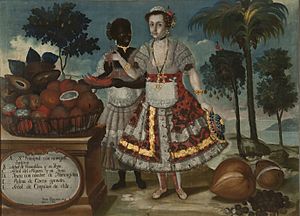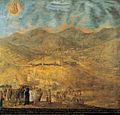Quito School facts for kids

The Quito School (also called Escuela Quiteña) was a famous art style from Latin America. It grew in the area known as the Royal Audience of Quito during the time of the Spanish Empire (1542–1824). This art was especially popular in the 1600s and 1700s.
Most of the art from the Quito School was religious. It was made for the Catholic Church. Artists were very good at making things look real. They also mixed in ideas and traditions from local Indigenous cultures. This art was very important for the economy of the Royal Audience of Quito. It was so respected that even King Carlos III of Spain (1716–1788) once said about a sculptor named Caspicara: "I am not concerned that Italy has Michelangelo; in my colonies of America I have the master Caspicara".
Contents
How the Quito School Started
The Quito School began in 1552. A Franciscan priest named Jodoco Ricke started a school of arts and crafts. He worked with Friar Pedro Bedón to change the San Andrés seminary. This is where the first Indigenous artists learned their skills.
This art style shows a mix of cultures. It came from a long process where Indigenous people and Europeans shared ideas. It is a great example of how different cultures can blend together.
What Makes Quito School Art Special
The art from the Quito School combines European and Indigenous features. This mix is called cultural syncretism and miscegenation. Over time, the art showed different styles popular in Spain. It had elements of renaissance and mannerist art.
When it was most popular, it was mainly baroque in style. Later, it had a short rococo period. It then started to move towards neoclassicism before the country became a republic. The Quito School also used ideas from Flemish, Italian, and Moorish art.
Painting Skin in Sculptures
One special technique used was called encarnado. This means "flesh-colored." It made the skin on sculptures look very natural. First, artists would shape and smooth the wood. Then, they covered it with many layers of gesso mixed with glue. Each layer was polished to make it smooth.
After that, they added color in thin, see-through layers. This created a mix of colors. They started with shadow colors like blue, green, and yellow. Then, they added lighter colors like white, pink, and yellow. Finally, they added bright highlights. For example, orange and red were used on cheeks and elbows of children. Dark blue, green, and violet were used for wounds on Christ or stubble on faces.
Other Unique Art Features
Other things that make Quito School art special include:
- Bodies in sculptures often look like they are moving in a wavy, snake-like way.
- Artists sometimes put aguada (watercolor) over gold leaf or silver paint. This gave the art a special metallic shine.
Indigenous Influences in the Art
The art also shows its Indigenous roots in several ways:
- Characters in the art often have mixed features and wear local clothes.
- You can often see old Indigenous customs in the paintings and sculptures.
- The scenes are often set in the Andes mountains or local cities.
- Artists included local plants and animals. They sometimes replaced traditional European plants with local ones.
Famous Artists of the Quito School
Painters
- Vicente Albán
- Friar Pedro Bedón
- Nicolás Javier Goríbar
- Hernando de la Cruz
- Miguel de Santiago (born around 1620s, died 1706)
- Manuel de Samaniego
- Isabel de Santiago
- Friar Pedro Gosseal
Sculptors
- Bernardo de Legarda (born around 1700, died 1773)
- Manuel Chili (also known as Caspicara)
- Miguel Angel Tejada Zambrano
- María Estefanía Dávalos y Maldonado
-
Virgin of Quito” by Bernardo de Legarda. The wooden sculpture follows the theme of the Woman of the Apocalypse.
-
Close-up view of “St. Joseph's Workshop” by Manuel de Samaniego. Oil on canvas, 51 x 69.4 cm, 18th century. Quito, Ecuador. MUNA.
-
“Procession during the time of drought” from the painting series “The Virgin of Guápulo's miracles” (1699-1706) by Miguel de Santiago. Oil on canvas, 137 x 137 cm. Santiago de Guápulo, Quito, Ecuador.
-
Replica of “Hell” by Hernando de la Cruz, 17th century. Iglesia de la Compañía, Quito, Ecuador.
See also
 In Spanish: Escuela Quiteña para niños
In Spanish: Escuela Quiteña para niños








